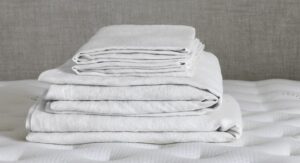Soft vs. Firm Mattresses: How to Choose Mattress Firmness
Disclosure: By clicking on the product links in this article, Mattress Nerd may receive a commission fee at no cost to you, the reader. Read full disclosure statement.
From the size to the construction of a bed, there’s lots of factors that go into finding the best mattress for you. Choosing the right mattress firmness can be the difference between a supported, restful night’s sleep and a night spent tossing and turning.
Here’s how soft vs. firm mattresses differ and how to choose the right firmness for you.
How Mattress Firmness is Measured
Generally, mattress firmness is measured on a scale from 1 to 10 with 1 being the softest and 10 being the firmest.
Mattress companies might also use their own unique firmness scale, though, that isn’t easy to compare apples-to-apples to other brands. The terms “soft” and “firm” can also be subjective. As a result, what may feel like a firm mattress from one company may feel like a different level of firmness from another.
Factors to Consider
Factors like how you sleep and what type of pillow you use can help you decide which firmness will be best for your mattress.
Sleeping Position
Your preferred sleeping position plays a big part in your ideal firmness level. For example, a recent study showed a mattress that is too soft allows the hips and shoulders to sink too much, which may lead to discomfort. So, a firmer mattress might be best if you sleep on your side.
On the other hand, a too-firm mattress needs to let the shoulders sink into the bed more. That can lead to poor neck support and pain. So, a softer mattress may be better if you’re a back sleeper.
Finally, if you sleep on your stomach, consider a firm mattress to promote better spine alignment.
Body Type
How much you weigh can help determine the mattress firmness that’s best for you. Heavy sleepers over 230 lbs, for example, will typically be most comfortable on a supportive, firmer mattress. Lightweight sleepers under 130 lbs, on the other hand, may find that a more contouring, softer mattress provides them with more pressure relief.
Pillow Loft
Another step is matching your mattress’s firmness with the pillow loft. Your bed may feel better with the right pillow height.
For example, a thicker pillow might be best with a firm mattress. So, consider a high loft. But a softer mattress might feel better with a lower or thinner pillow loft.
The pillow and mattress should work together to support your neck and back.
Age
As you move through the stages of life, you may find your preferred mattress firmness varies.
Recent research points out that The American Academy of Pediatrics (AAP) recommends a firm mattress for infants. Then, they can move to a softer mattress as they advance to adolescents.
As you age into adulthood, you may experience injury or arthritis in your back, shoulders, or neck. Then, a medium-firm mattress might better promote comfort and alignment to help with the pain.
Older adults typically experience age-related sleep changes. As a result, you may wake up more often and not get enough hours of sleep. A supportive yet softer mattress might help improve sleep quality and help you fall asleep faster.
Body Pain
Your body makes contact with a mattress at different points. As a result, you might feel a certain amount of contact pressure each night. The parts of the body most affected by pressure are:
- buttocks
- hips
- shoulders
- back
A study looked at pressure points and identified certain mattress firmness levels and materials that may be best. For example, if you experience hip pain, a latex mattress will likely relieve pressure better. These types of mattresses are usually firmer mattress material.
Pressure-reducing foam mattresses (PRFM) made of a material like memory foam are also a consideration if you experience pain. Memory foam isn’t typically very firm, but still very supportive. Compared to other mattresses, a PRFM mattress holds an 88 percent reduced likelihood of developing pressure injuries while sleeping.
Finding the Right Firmness for a Couple
You and your partner have your own needs. So, your ideal mattress firmness may not be suitable for your partner. How can you compromise? You have a few options.
- Buy a smart mattress. The technology allows you to choose a different level of firmness for your side of the bed while your partner chooses their own.
- Look for a mattress that’s right in the middle. You both may find the most comfort from a medium-firm mattress. One that’s not too soft or too hard. It may also be the most cost-effective solution.
- Sleep separately. Many couples sleep separately to ensure they get the rest they need. This choice allows each person to buy the best mattress, leading to a better night’s sleep.
Frequently Asked Questions
Is it better to sleep on a firm or soft mattress?
The best mattress firmness all depends on your individual needs. Your doctor or chiropractor might be a great person to ask for advice on what you need. Also, you can trust your gut on what feels suitable for you. If you’re still unsure, many mattress companies offer a free trial period to try it at home for a few nights and see if you like it.
Is my mattress too soft or too firm?
To determine if your mattress is too soft or firm, pay attention to how you feel when you wake up and go through your daily activities.
For example, ask yourself:
- Are you experiencing back, neck, or hip pain?
- Are you waking up frequently in the night due to discomfort?
- Are you tossing and turning at night and finding it difficult to fall asleep?
It may be your mattress is too soft or too firm.
Takeaway
Now you know what factors to consider when choosing a mattress. When it’s all considered, you mainly want to ensure you’re buying a supportive mattress. Firmness and support are related, but they’re not the same. So, maybe consider that before purchasing the firmest bed when a soft, supportive bed may feel better.
Source List
Caggiari G, et al. (2021). What type of mattress should be chosen to avoid back pain and improve sleep quality? Review of literature. https://media.proquest.com/media/hms/PFT/1/dgOkL?_s=L6srWCXhSASfHsM08AY79LWgeUA%3D
Gillani S, et al. (2021). A firm recommendation: measuring the softness of infant sleep surfaces. https://www.ncbi.nlm.nih.gov/pmc/articles/PMC8436463/
Li Bai D, et al. (2020). Relationship between a pressure redistributing foam mattress and pressure injuries: An observational prospective cohort study. https://journals.plos.org/plosone/article?id=10.1371/journal.pone.0241276
Low F, et al. (2017). Effects of mattress material on body pressure profiles in different sleeping postures. https://www.ncbi.nlm.nih.gov/pmc/articles/PMC5310954/
Suzuki K, et al. (2017). Sleep disorders in the elderly: Diagnosis and management. https://www.ncbi.nlm.nih.gov/pmc/articles/PMC5689397/


